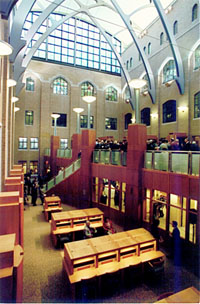The new Irving S. Gilmore Music Library was formally dedicated on Oct. 16. Among the guests who gathered for the occasion were President Richard C. Levin and other Yale officers; University Librarian Scott Bennett; Kendall Crilly, the Andrew W. Mellon Foundation Music Librarian; trustees of the Irving S. Gilmore Foundation; and library staff.
Housed within Sterling Memorial Library at 120 High St., the library is named for the late Irving Gilmore, a 1923 graduate of Yale who made a significant contribution toward the construction of the new facility through a bequest. The University subsequently received a gift for the new building from the Irving S. Gilmore Foundation, established in 1972 in Kalamazoo, Mich.
The new facility was designed by Shepley, Bulfinch, Richardson and Abbott of Boston. The dedication marks the completion of an 18-month, $11 million construction project managed by Barr & Barr Inc. of New Haven.
Before the Gilmore Library was built, the music library was located a block away in Sprague Memorial Hall, in a facility named for John Herrick Jackson. However, as Yale's music holdings grew to the approximately 160,000 books, scores, recordings and other works that now comprise the collection, a larger space was needed. With the opening of the new library, the University's principal music collections -- many of which had to be shelved in other libraries -- once again have been brought together in one location.
'Spectacular addition.'
"We have needed this library for decades," notes Bennett, "and it was wonderful finally to be able to build it. I think the richest and most exciting reward was to see music students in the library literally the first hour we opened. As soon as the first listening equipment was out of the box, a student was there. We still were in some disarray, but students were there. I said to my colleagues, 'This is why we built this place.' It's a wonderful magnet for students and faculty. We are ecstatic."
Because it is located within Sterling Library, the new full-service facility is commonly referred to as a "library within a library." The structure consists of approximately 13,000 square feet of new space, which was created in Sterling's second courtyard, and approximately 13,000 square feet of surrounding renovated space within Sterling.
Book stacks and a Historical Sound Recording Studio are located on the ground level. The first floor has a listening area, two seminar rooms, offices and an exhibition space. On the mezzanine level are the reading area, periodical stacks, offices and a technical services area. Soaring approximately 60 feet above the mezzanine is a new, dramatic arched truss roof structure that allows indirect natural light into the new library. All reader areas are wired for power and data transmission.
Even before the study of music formally became part of the Yale curriculum, the University had a music collection. Mid-19th-century acquisitions, which supported religious scholarship, included works by Bach, Beethoven, Handel, Mendelssohn, Mozart, Schumann and Lowell Mason, whose family gave his large library -- more than 10,000 volumes -- to Yale after his death. Over the years the library has grown to include vast collections of both sacred and secular works, including musical performance scores and parts, books on the theory and history of music, sound recordings in all formats, music manuscripts, periodicals, extensive collections of composers' personal papers and archives, and rare editions.
Materials in Yale's music library are used to meet the research and performing needs of Yale's graduate and undergraduate students in the School of Music, the music department and the Institute of Sacred Music. It is also used by music scholars from around the world.
The construction of the Gilmore Library was initiated by Levin, who describes the new facility as "a spectacular addition to the University." The President adds: "As a physical entity, it is an impressive and ample space in which to house our music collections. But it's more than that. This new library is a place where music scholarship can thrive -- where discussions, performances and the excitement of discovery can occur comfortably under one roof."

PHOTO BY MICHAEL MARSLAND
| The Irving S. Gilmore Music Library at Yale University
| |
 October 26-November 2, 1998
October 26-November 2, 1998